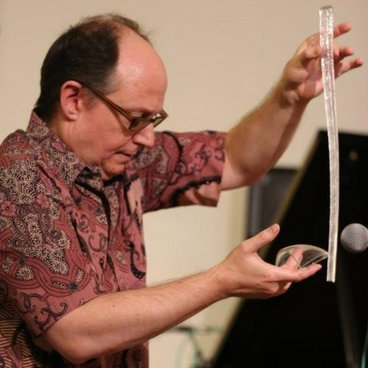Miguel Frasconi

Miguel Frasconi:
"(born 1956, New York City) is a composer and performer of new exploratory world music. By combining traditional western and non-western instruments with experimental forms, modern electronics, glass and other devolved instruments, he creates a music that sounds from a uniquely imagined tradition. As a keyboard player and glass musician he has worked with many of new music's most respected composers, including John Cage, Brian Eno, Jon Hassell, and James Tenney. As a percussionist he has spent many years studying the music of South India, West Africa, and Indonesia. As a performance artist he has explored early 20th century experimental forms, including the work of the dada and fluxus movements. Frasconi's early work includes ten years as a founding member of The Glass Orchestra, Toronto's internationally acclaimed new music ensemble featuring all glass instruments. He has continued this exploration of glass in his solo and ensemble music, performing on a number of new musical instruments he has developed over the years."
http://frasconimusic.com/blog/
*********************************************************************************************************************************************************************************

Solo and ensemble music for glass bellbowls, mbiras, voice, toy pianos, electronics and devolved musical instruments, featuring vocalist Eda Maxym
"The "Song" in Song + Distance refers not to the various popular song structures we hear everyday but, rather, to the concept of expression. The song in "singing one's heart out." The "Distance" refers to the concept of experience. The moment we experience something we are immediately at a distance from it. We retain our experience of the event but not the event itself. The song helps us choose the quality of this distance and the depth of the experience. Song and distance, expression and experience, emotion and memory, melody and the sounds around us."
- New Albion Records - 2000

Comments
(Porter Records - 2010)
- "Miguel Frasconi uses a menagerie of glass objects to create music from a uniquely imagined tradition. These objects are struck, blown, stroked and otherwise coaxed into vibration. Miguel has worked with the likes of renowned composers, John Cage, Brian Eno and James Tenney, and his studies have ranged from the music of Indonesia to the Fluxus movement. Denman Maroney plays what he calls hyperpiano, which involves bowing and sliding the strings with steel cylinders, Tibetan prayer bowls, rubber blocks and CD cases to create a unique sonic vocabulary. Denman also uses a system of temporal harmony based on the undertone series that allows him to improvise and compose in several tempos at once. With their release of Gleam, these two visionary musicians come together to take the listener through a dream like landscape of otherworldly sounds."
Miguel Frasconi - The RIOT of SPRING by 16 Stravinskys
released 29 May 2013
- "The Riot of Spring, for 16 orchestras.
Sixteen different recordings of Igor Stravinsky's The Rite of Spring, played simultaneously. Conceived and realized by Miguel Frasconi.
This version created in honor of the 100th anniversary of the premiere performance of Le Sacre du printemps, which took place May 29, 1913.
The Riot of Spring (An Orchestra of Orchestras) was first performed in 2006 on Stephan Moore's 16 speaker array, with a different orchestra in each speaker. It was commissioned by Suzanne Fiol and ISSUE Project Room for the first annual Floating Points festival."
I had of course listened to music before, live and otherwise, but this music did not sound like anything I had ever heard. To my young ear this did not sound like music but more like weather; as turbulent and unexpected as a storm. I left there thinking, if a human being can create something that sounds like weather, that is what I want to learn how to do. I was hooked on wanting to make something that seemed more than just "music." I started playing piano then later discovered recordings of early electronic music and kept following that lead."